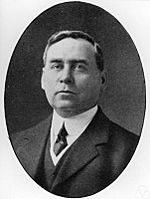John Charles Fields facts for kids
Quick facts for kids
John Charles Fields
|
|
|---|---|

John Charles Fields
|
|
| Born | May 14, 1863 Hamilton, Canada West
|
| Died | August 9, 1932 (aged 69) Toronto, Ontario
|
| Resting place | Hamilton Cemetery |
| Nationality | Canadian |
| Known for | Fields Medal, Fields Institute |
| Scientific career | |
| Fields | Mathematics |
| Thesis | Symbolic Finite Solutions and Solutions by Definite Integrals of the Equation dny/dxn = xmy (1886) |
| Doctoral students | Samuel Beatty |
John Charles Fields (born May 14, 1863 – died August 9, 1932) was a Canadian mathematician. He is famous for creating the Fields Medal. This award is given to mathematicians for their amazing work.
Contents
Early Life and Education
John Charles Fields was born in Hamilton, Canada West. His father owned a leather shop. John finished high school at Hamilton Collegiate Institute in 1880.
He then went to the University of Toronto, graduating in 1884. After that, he moved to the United States. He studied at Johns Hopkins University in Baltimore. Fields earned his Ph.D. degree in 1887. A Ph.D. is a very high university degree. His main research was in mathematics.
Time in Europe
Fields taught at Johns Hopkins for two years. Then he joined the faculty at Allegheny College in Meadville. At that time, he felt that mathematical research in North America was not very strong.
So, in 1891, he decided to go to Europe. He spent time in cities like Berlin, Göttingen, and Paris. There, he met many of the best mathematicians of his time. These included famous names like Karl Weierstrass and Felix Klein. He also became lifelong friends with Gösta Mittag-Leffler. During this time, Fields started writing papers about algebraic functions. This became a very important area of his math research.
Return to Canada and Achievements
In 1902, Fields came back to Canada. He became a lecturer at the University of Toronto. Once home, he worked very hard to make mathematics more important. He wanted to improve how math was seen in universities and by the public.
He helped convince the government to give $75,000 each year for research at the university. He also helped start the National Research Council of Canada. This council supports scientific research across the country. Fields was also the president of the Royal Canadian Institute from 1919 to 1925. He tried to make it a top place for science research.
His efforts were key in bringing the 1924 International Congress of Mathematicians (ICM) to Toronto. This is a very big meeting where mathematicians from all over the world share their ideas. Fields was also asked to speak at the ICM in 1912, 1924, and 1928.
The Fields Medal
John Charles Fields is most famous for creating the Fields Medal. Many people think of it as the "Nobel Prize of mathematics." However, there are some differences between the two awards.
The Fields Medal was first given out in 1936. After a break, it was brought back in 1950. Since then, it has been awarded every four years. The medal is given to two, three, or four mathematicians. They must be under 40 years old. The award honors them for their important discoveries in mathematics.
Fields started planning the award in the late 1920s. But his health got worse. He sadly passed away on August 9, 1932, after being sick for three months. He never got to see his medal awarded. In his will, he left $47,000 to start the Fields Medal fund. His friend J. L. Synge helped finish the plans for the medal.
Honours and Legacy
John Charles Fields received many honors for his work. He was chosen as a fellow of the Royal Society of Canada in 1907. In 1913, he became a fellow of the Royal Society of London. These are very respected groups for scientists.
The Fields Institute at the University of Toronto is named after him. This institute is a center for mathematical research.
See also
 In Spanish: John Charles Fields para niños
In Spanish: John Charles Fields para niños

